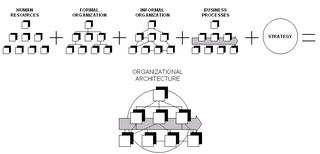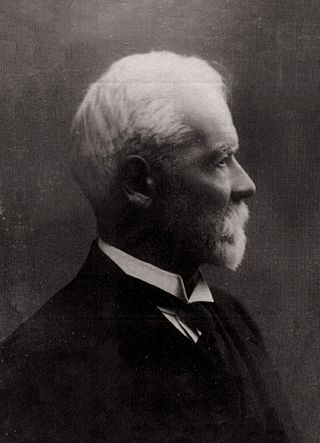Management is the administration of organizations, whether they are a business, a nonprofit organization, or a government body through business administration, nonprofit management, or the political science sub-field of public administration respectively. It is the process of managing the resources of businesses, governments, and other organizations.
Human resources (HR) is the set of people who make up the workforce of an organization, business sector, industry, or economy. A narrower concept is human capital, the knowledge and skills which the individuals command. Similar terms include manpower, labor, or personnel.

An organization or organisation, is an entity—such as a company, an institution, or an association—comprising one or more people and having a particular purpose.
Delegation is the process of distributing and entrusting work to another person. In management or leadership within an organisation, it involves a manager aiming to efficiently distribute work, decision-making and responsibility to subordinate workers in an organization. Delegation may result in creation of an accountable chain of authority where authority and responsibility moves down in an organisational structure. Inefficient delegation may lead to micromanagement.
Career development refers to the process an individual may undergo to evolve their occupational status. It is the process of making decisions for long term learning, to align personal needs of physical or psychological fulfillment with career advancement opportunities. Career Development can also refer to the total encompassment of an individual's work-related experiences, leading up to the occupational role they may hold within an organization.
Middle management is the intermediate management level of a hierarchical organization that is subordinate to the executive management and responsible for "team leading" line managers and/or "specialist" line managers. Middle management is indirectly responsible for junior staff performance and productivity.
Team management is the ability of an individual or an organization to administer and coordinate a group of individuals to perform a task. Team management involves teamwork, communication, objective setting and performance appraisals. Moreover, team management is the capability to identify problems and resolve conflicts within a team. Teams are a popular approach to many business challenges. They can produce innovative solutions to complex problems. There are various methods and leadership styles a team manager can take to increase personnel productivity and build an effective team. In the workplace teams can come in many shapes and sizes who all work together and depend on one another. They communicate and all strive to accomplish a specific goal. Management teams are a type of team that performs duties such as managing and advising other employees and teams that work with them. Whereas work, parallel, and project teams hold the responsibility of direct accomplishment of a goal, management teams are responsible for providing general direction and assistance to those teams.
Management by objectives (MBO), also known as management by planning (MBP), was first popularized by Peter Drucker in his 1954 book The Practice of Management. Management by objectives is the process of defining specific objectives within an organization that management can convey to organization members, then deciding how to achieve each objective in sequence. This process allows managers to take work that needs to be done one step at a time to allow for a calm, yet productive work environment. In this system of management, individual goals are synchronized with the goals of the organization.
An organizational structure defines how activities such as task allocation, coordination, and supervision are directed toward the achievement of organizational aims.
Span of control, also called span of management, is a term used in business management, particularly human resource management. The term refers to the number of subordinates or direct reports a supervisor is responsible for.

The Incident Command System (ICS) is a standardized approach to the command, control, and coordination of emergency response providing a common hierarchy within which responders from multiple agencies can be effective.

Organizational architecture, also known as organizational design, is a field concerned with the creation of roles, processes, and formal reporting relationships in an organization. It refers to architecture metaphorically, as a structure which fleshes out the organizations. The various features of a business's organizational architecture has to be internally consistent in strategy, architecture and competitive environment.
Office management is a profession involving the design, implementation, evaluation, and maintenance of the process of work within an office or other organization, in order to sustain and improve efficiency and productivity.
Lateral communication is "the exchange, imparting or sharing of information, ideas or feelings between people within a community, peer groups, departments or units of an organization who are at or about the same hierarchical level as each other for the purpose of coordinating activities, efforts or fulfilling a common purpose or goal
A functional manager is a person who has management authority over an organizational unit—such as a department—within a business, company, or other organization. Functional managers have ongoing responsibilities, and are not usually directly affiliated with project teams, other than ensuring that goals and objectives align with the organization's overall strategy and vision.
Staff management is the management of subordinates in an organization. Often, large organizations have many of these functions performed by a specialist department, such as personnel or human resources, but all line managers are still required to supervise and administer the activities and ensure the well-being of the staff that report to them.
POSDCORB is an acronym widely used in the field of management and public administration that reflects the classic view of organizational theory. It appeared most prominently in a 1937 paper by Luther Gulick. However, he first presented the concept in 1935. Initially, POSDCORB was envisioned in an effort to develop public service professionals. In Gulick's own words, the elements are as follows: Planning, Organizing, Staffing, Directing, Co-Ordinating, Reporting and Budgeting.

The term director is a title given to the senior management staff of businesses and other large organizations.
Cross-cultural psychology attempts to understand how individuals of different cultures interact with each other. Along these lines, cross-cultural leadership has developed as a way to understand leaders who work in the newly globalized market. Today's international organizations require leaders who can adjust to different environments quickly and work with partners and employees of other cultures. It cannot be assumed that a manager who is successful in one country will be successful in another.

Fayolism was a theory of management that analyzed and synthesized the role of management in organizations, developed around 1900 by the French manager and management theorist Henri Fayol (1841–1925). It was through Fayol's work as a philosopher of administration that he contributed most widely to the theory and practice of organizational management.




